PMMP 20008: Initiating and Planning Projects - Lessons Learnt Report
VerifiedAdded on 2022/10/03
|11
|3498
|471
Report
AI Summary
This report, submitted as part of the PMMP20008 course, reflects on lessons learned during the initiating and planning phases of a project. It begins with an introduction to reflective practice and the importance of lessons learned frameworks in project management, emphasizing their role in continuous improvement and risk management. The report then outlines the framework, including inputs, processes, and outputs. It details the author's planned approach to gathering and documenting lessons, comparing it to the actual implementation, highlighting challenges faced such as documentation issues and analysis delays. The core of the report presents three key lessons: the importance of project scheduling, conflict resolution among stakeholders, and dealing with multiple tasks. Each lesson includes a reflection on the situation, the feelings it evoked, and the insights gained, followed by specific improvement strategies. The strategies address scheduling adherence, stakeholder communication, and task prioritization, outlining measurable steps, achievability, relevance, and implementation timelines. The report concludes by emphasizing the value of these lessons for future project success.
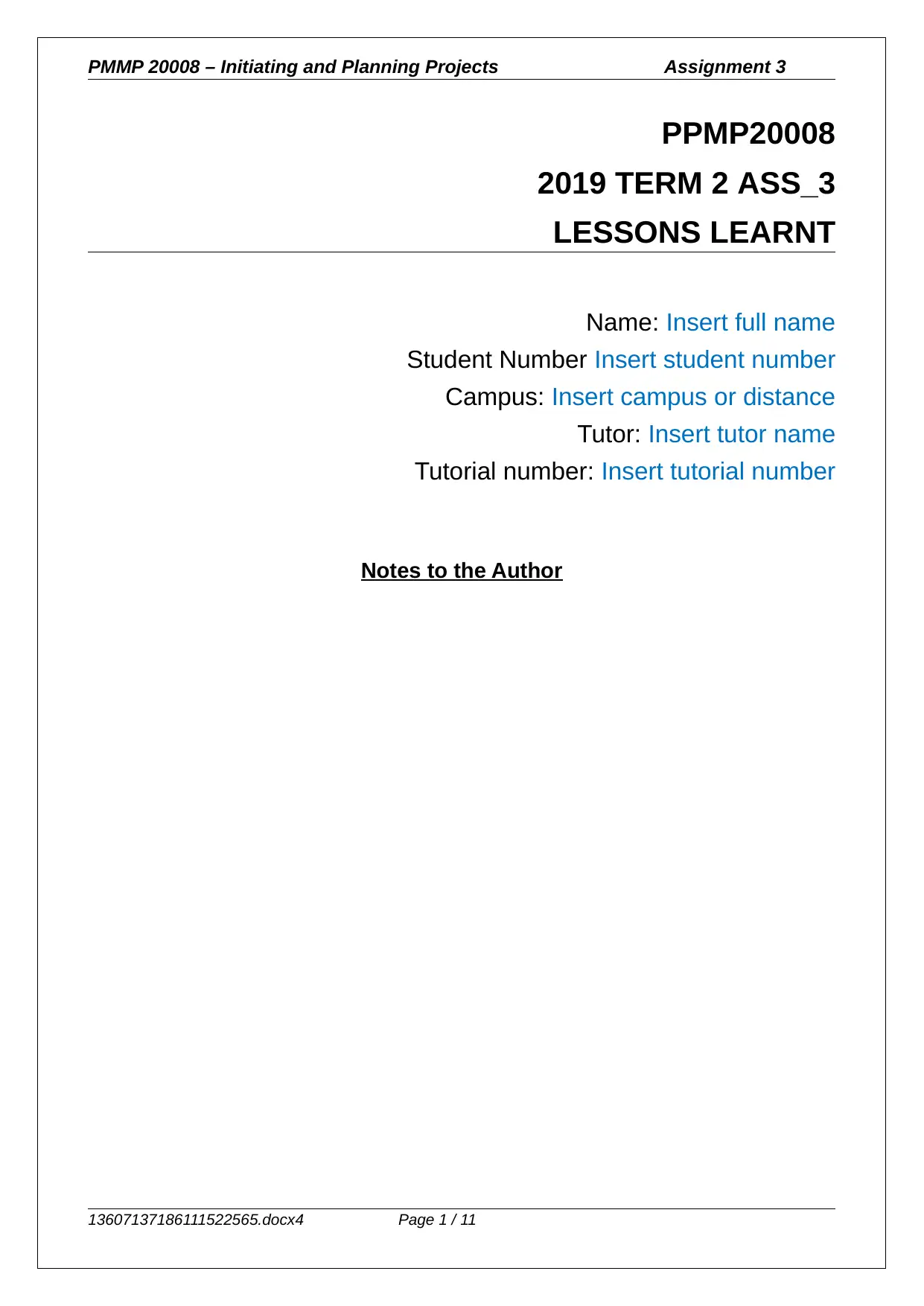
PMMP 20008 – Initiating and Planning Projects Assignment 3
PPMP20008
2019 TERM 2 ASS_3
LESSONS LEARNT
Name: Insert full name
Student Number Insert student number
Campus: Insert campus or distance
Tutor: Insert tutor name
Tutorial number: Insert tutorial number
Notes to the Author
13607137186111522565.docx4 Page 1 / 11
PPMP20008
2019 TERM 2 ASS_3
LESSONS LEARNT
Name: Insert full name
Student Number Insert student number
Campus: Insert campus or distance
Tutor: Insert tutor name
Tutorial number: Insert tutorial number
Notes to the Author
13607137186111522565.docx4 Page 1 / 11
Paraphrase This Document
Need a fresh take? Get an instant paraphrase of this document with our AI Paraphraser
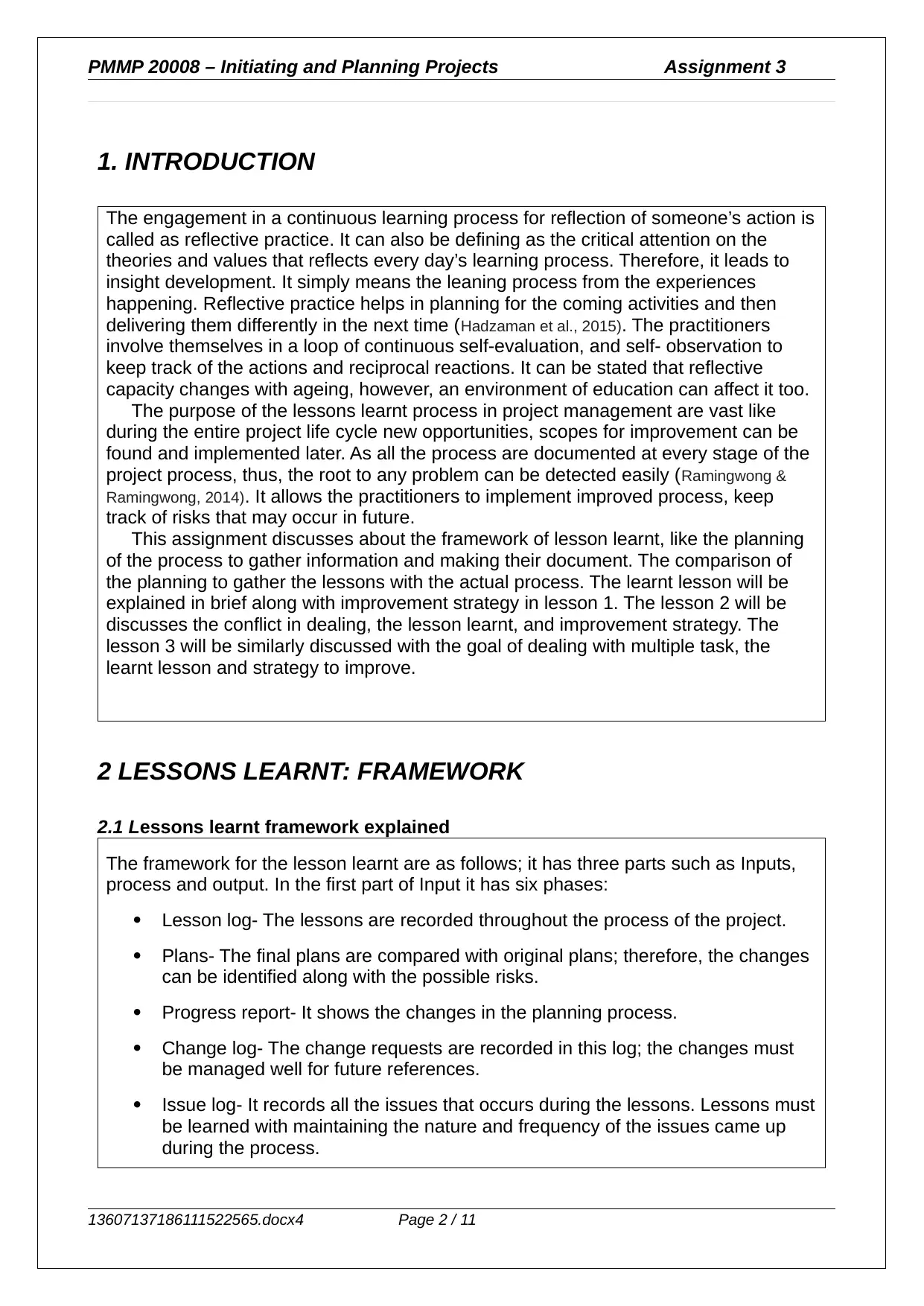
PMMP 20008 – Initiating and Planning Projects Assignment 3
1. INTRODUCTION
The engagement in a continuous learning process for reflection of someone’s action is
called as reflective practice. It can also be defining as the critical attention on the
theories and values that reflects every day’s learning process. Therefore, it leads to
insight development. It simply means the leaning process from the experiences
happening. Reflective practice helps in planning for the coming activities and then
delivering them differently in the next time (Hadzaman et al., 2015). The practitioners
involve themselves in a loop of continuous self-evaluation, and self- observation to
keep track of the actions and reciprocal reactions. It can be stated that reflective
capacity changes with ageing, however, an environment of education can affect it too.
The purpose of the lessons learnt process in project management are vast like
during the entire project life cycle new opportunities, scopes for improvement can be
found and implemented later. As all the process are documented at every stage of the
project process, thus, the root to any problem can be detected easily (Ramingwong &
Ramingwong, 2014). It allows the practitioners to implement improved process, keep
track of risks that may occur in future.
This assignment discusses about the framework of lesson learnt, like the planning
of the process to gather information and making their document. The comparison of
the planning to gather the lessons with the actual process. The learnt lesson will be
explained in brief along with improvement strategy in lesson 1. The lesson 2 will be
discusses the conflict in dealing, the lesson learnt, and improvement strategy. The
lesson 3 will be similarly discussed with the goal of dealing with multiple task, the
learnt lesson and strategy to improve.
2 LESSONS LEARNT: FRAMEWORK
2.1 Lessons learnt framework explained
The framework for the lesson learnt are as follows; it has three parts such as Inputs,
process and output. In the first part of Input it has six phases:
Lesson log- The lessons are recorded throughout the process of the project.
Plans- The final plans are compared with original plans; therefore, the changes
can be identified along with the possible risks.
Progress report- It shows the changes in the planning process.
Change log- The change requests are recorded in this log; the changes must
be managed well for future references.
Issue log- It records all the issues that occurs during the lessons. Lessons must
be learned with maintaining the nature and frequency of the issues came up
during the process.
13607137186111522565.docx4 Page 2 / 11
1. INTRODUCTION
The engagement in a continuous learning process for reflection of someone’s action is
called as reflective practice. It can also be defining as the critical attention on the
theories and values that reflects every day’s learning process. Therefore, it leads to
insight development. It simply means the leaning process from the experiences
happening. Reflective practice helps in planning for the coming activities and then
delivering them differently in the next time (Hadzaman et al., 2015). The practitioners
involve themselves in a loop of continuous self-evaluation, and self- observation to
keep track of the actions and reciprocal reactions. It can be stated that reflective
capacity changes with ageing, however, an environment of education can affect it too.
The purpose of the lessons learnt process in project management are vast like
during the entire project life cycle new opportunities, scopes for improvement can be
found and implemented later. As all the process are documented at every stage of the
project process, thus, the root to any problem can be detected easily (Ramingwong &
Ramingwong, 2014). It allows the practitioners to implement improved process, keep
track of risks that may occur in future.
This assignment discusses about the framework of lesson learnt, like the planning
of the process to gather information and making their document. The comparison of
the planning to gather the lessons with the actual process. The learnt lesson will be
explained in brief along with improvement strategy in lesson 1. The lesson 2 will be
discusses the conflict in dealing, the lesson learnt, and improvement strategy. The
lesson 3 will be similarly discussed with the goal of dealing with multiple task, the
learnt lesson and strategy to improve.
2 LESSONS LEARNT: FRAMEWORK
2.1 Lessons learnt framework explained
The framework for the lesson learnt are as follows; it has three parts such as Inputs,
process and output. In the first part of Input it has six phases:
Lesson log- The lessons are recorded throughout the process of the project.
Plans- The final plans are compared with original plans; therefore, the changes
can be identified along with the possible risks.
Progress report- It shows the changes in the planning process.
Change log- The change requests are recorded in this log; the changes must
be managed well for future references.
Issue log- It records all the issues that occurs during the lessons. Lessons must
be learned with maintaining the nature and frequency of the issues came up
during the process.
13607137186111522565.docx4 Page 2 / 11
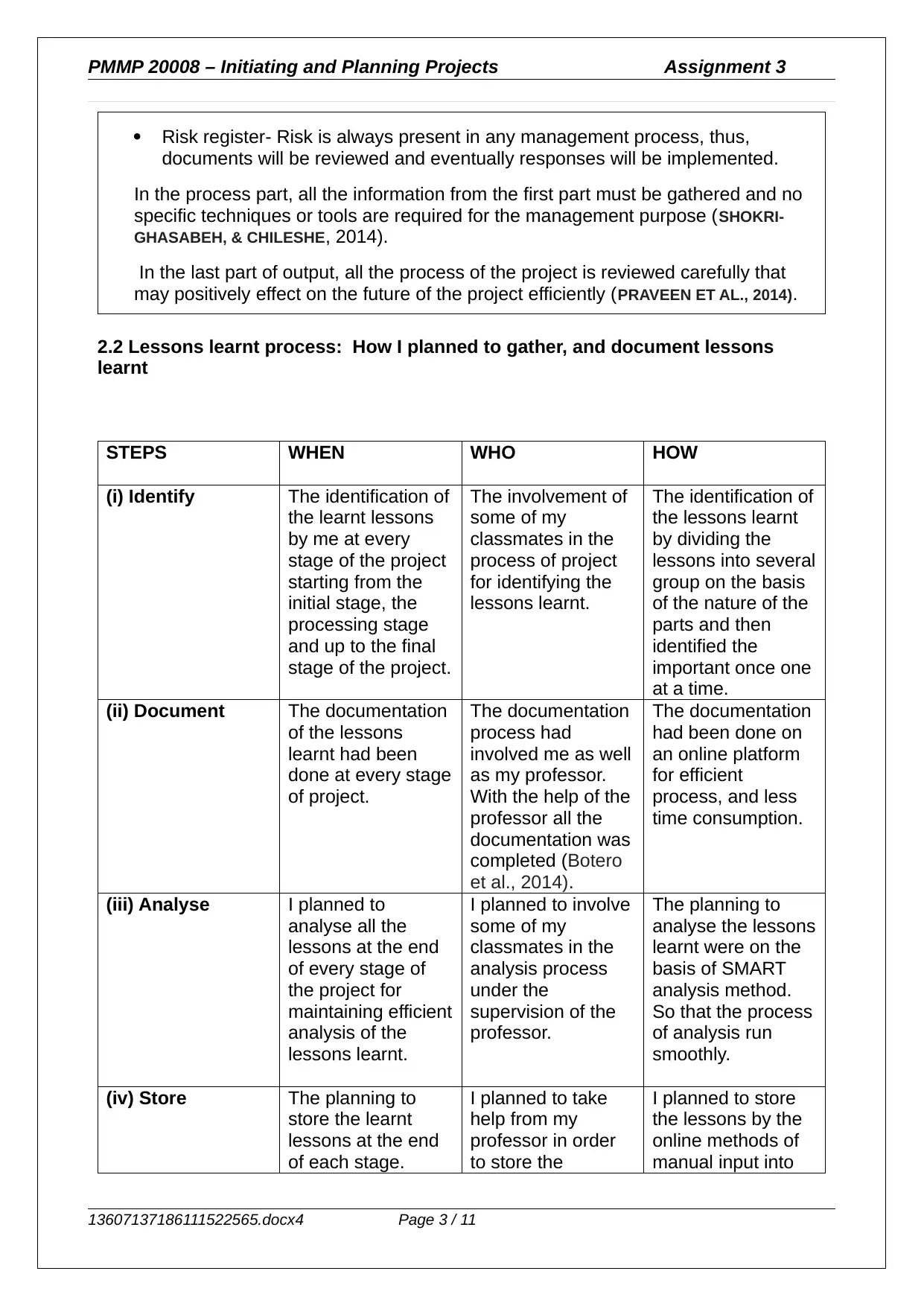
PMMP 20008 – Initiating and Planning Projects Assignment 3
Risk register- Risk is always present in any management process, thus,
documents will be reviewed and eventually responses will be implemented.
In the process part, all the information from the first part must be gathered and no
specific techniques or tools are required for the management purpose (SHOKRI-
GHASABEH, & CHILESHE, 2014).
In the last part of output, all the process of the project is reviewed carefully that
may positively effect on the future of the project efficiently (PRAVEEN ET AL., 2014).
2.2 Lessons learnt process: How I planned to gather, and document lessons
learnt
STEPS WHEN WHO HOW
(i) Identify The identification of
the learnt lessons
by me at every
stage of the project
starting from the
initial stage, the
processing stage
and up to the final
stage of the project.
The involvement of
some of my
classmates in the
process of project
for identifying the
lessons learnt.
The identification of
the lessons learnt
by dividing the
lessons into several
group on the basis
of the nature of the
parts and then
identified the
important once one
at a time.
(ii) Document The documentation
of the lessons
learnt had been
done at every stage
of project.
The documentation
process had
involved me as well
as my professor.
With the help of the
professor all the
documentation was
completed (Botero
et al., 2014).
The documentation
had been done on
an online platform
for efficient
process, and less
time consumption.
(iii) Analyse I planned to
analyse all the
lessons at the end
of every stage of
the project for
maintaining efficient
analysis of the
lessons learnt.
I planned to involve
some of my
classmates in the
analysis process
under the
supervision of the
professor.
The planning to
analyse the lessons
learnt were on the
basis of SMART
analysis method.
So that the process
of analysis run
smoothly.
(iv) Store The planning to
store the learnt
lessons at the end
of each stage.
I planned to take
help from my
professor in order
to store the
I planned to store
the lessons by the
online methods of
manual input into
13607137186111522565.docx4 Page 3 / 11
Risk register- Risk is always present in any management process, thus,
documents will be reviewed and eventually responses will be implemented.
In the process part, all the information from the first part must be gathered and no
specific techniques or tools are required for the management purpose (SHOKRI-
GHASABEH, & CHILESHE, 2014).
In the last part of output, all the process of the project is reviewed carefully that
may positively effect on the future of the project efficiently (PRAVEEN ET AL., 2014).
2.2 Lessons learnt process: How I planned to gather, and document lessons
learnt
STEPS WHEN WHO HOW
(i) Identify The identification of
the learnt lessons
by me at every
stage of the project
starting from the
initial stage, the
processing stage
and up to the final
stage of the project.
The involvement of
some of my
classmates in the
process of project
for identifying the
lessons learnt.
The identification of
the lessons learnt
by dividing the
lessons into several
group on the basis
of the nature of the
parts and then
identified the
important once one
at a time.
(ii) Document The documentation
of the lessons
learnt had been
done at every stage
of project.
The documentation
process had
involved me as well
as my professor.
With the help of the
professor all the
documentation was
completed (Botero
et al., 2014).
The documentation
had been done on
an online platform
for efficient
process, and less
time consumption.
(iii) Analyse I planned to
analyse all the
lessons at the end
of every stage of
the project for
maintaining efficient
analysis of the
lessons learnt.
I planned to involve
some of my
classmates in the
analysis process
under the
supervision of the
professor.
The planning to
analyse the lessons
learnt were on the
basis of SMART
analysis method.
So that the process
of analysis run
smoothly.
(iv) Store The planning to
store the learnt
lessons at the end
of each stage.
I planned to take
help from my
professor in order
to store the
I planned to store
the lessons by the
online methods of
manual input into
13607137186111522565.docx4 Page 3 / 11
⊘ This is a preview!⊘
Do you want full access?
Subscribe today to unlock all pages.

Trusted by 1+ million students worldwide
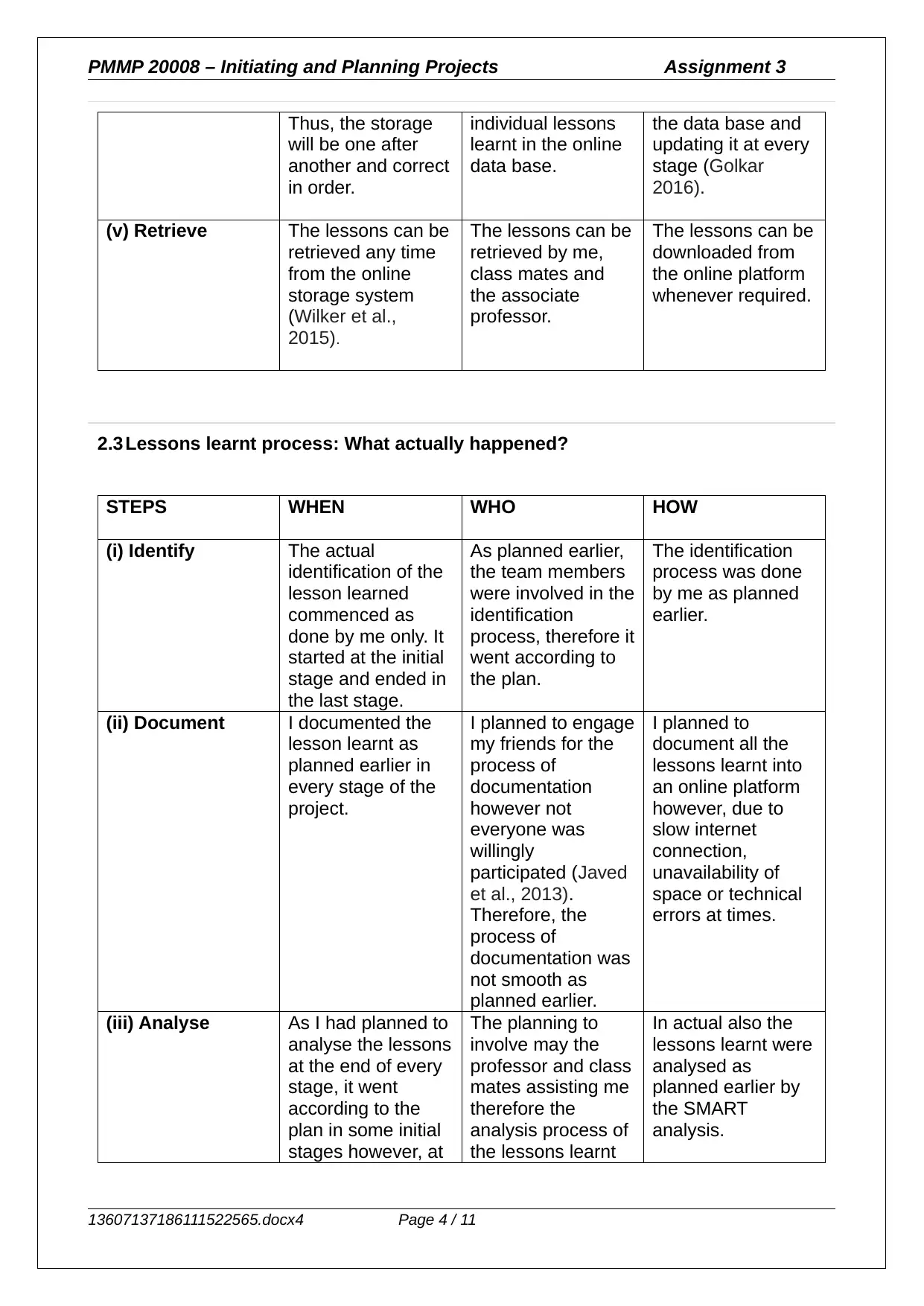
PMMP 20008 – Initiating and Planning Projects Assignment 3
Thus, the storage
will be one after
another and correct
in order.
individual lessons
learnt in the online
data base.
the data base and
updating it at every
stage (Golkar
2016).
(v) Retrieve The lessons can be
retrieved any time
from the online
storage system
(Wilker et al.,
2015).
The lessons can be
retrieved by me,
class mates and
the associate
professor.
The lessons can be
downloaded from
the online platform
whenever required.
2.3 Lessons learnt process: What actually happened?
STEPS WHEN WHO HOW
(i) Identify The actual
identification of the
lesson learned
commenced as
done by me only. It
started at the initial
stage and ended in
the last stage.
As planned earlier,
the team members
were involved in the
identification
process, therefore it
went according to
the plan.
The identification
process was done
by me as planned
earlier.
(ii) Document I documented the
lesson learnt as
planned earlier in
every stage of the
project.
I planned to engage
my friends for the
process of
documentation
however not
everyone was
willingly
participated (Javed
et al., 2013).
Therefore, the
process of
documentation was
not smooth as
planned earlier.
I planned to
document all the
lessons learnt into
an online platform
however, due to
slow internet
connection,
unavailability of
space or technical
errors at times.
(iii) Analyse As I had planned to
analyse the lessons
at the end of every
stage, it went
according to the
plan in some initial
stages however, at
The planning to
involve may the
professor and class
mates assisting me
therefore the
analysis process of
the lessons learnt
In actual also the
lessons learnt were
analysed as
planned earlier by
the SMART
analysis.
13607137186111522565.docx4 Page 4 / 11
Thus, the storage
will be one after
another and correct
in order.
individual lessons
learnt in the online
data base.
the data base and
updating it at every
stage (Golkar
2016).
(v) Retrieve The lessons can be
retrieved any time
from the online
storage system
(Wilker et al.,
2015).
The lessons can be
retrieved by me,
class mates and
the associate
professor.
The lessons can be
downloaded from
the online platform
whenever required.
2.3 Lessons learnt process: What actually happened?
STEPS WHEN WHO HOW
(i) Identify The actual
identification of the
lesson learned
commenced as
done by me only. It
started at the initial
stage and ended in
the last stage.
As planned earlier,
the team members
were involved in the
identification
process, therefore it
went according to
the plan.
The identification
process was done
by me as planned
earlier.
(ii) Document I documented the
lesson learnt as
planned earlier in
every stage of the
project.
I planned to engage
my friends for the
process of
documentation
however not
everyone was
willingly
participated (Javed
et al., 2013).
Therefore, the
process of
documentation was
not smooth as
planned earlier.
I planned to
document all the
lessons learnt into
an online platform
however, due to
slow internet
connection,
unavailability of
space or technical
errors at times.
(iii) Analyse As I had planned to
analyse the lessons
at the end of every
stage, it went
according to the
plan in some initial
stages however, at
The planning to
involve may the
professor and class
mates assisting me
therefore the
analysis process of
the lessons learnt
In actual also the
lessons learnt were
analysed as
planned earlier by
the SMART
analysis.
13607137186111522565.docx4 Page 4 / 11
Paraphrase This Document
Need a fresh take? Get an instant paraphrase of this document with our AI Paraphraser
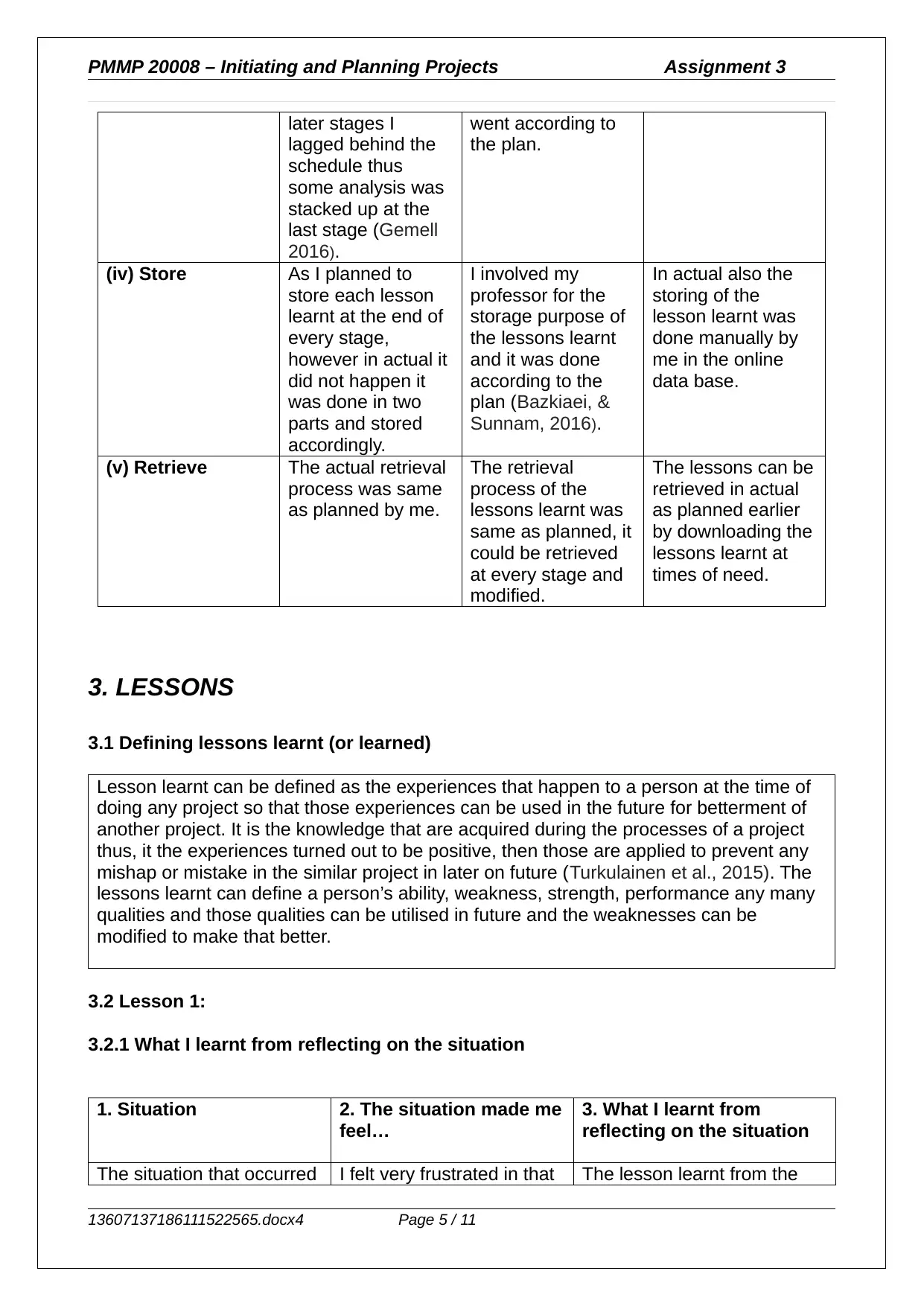
PMMP 20008 – Initiating and Planning Projects Assignment 3
later stages I
lagged behind the
schedule thus
some analysis was
stacked up at the
last stage (Gemell
2016).
went according to
the plan.
(iv) Store As I planned to
store each lesson
learnt at the end of
every stage,
however in actual it
did not happen it
was done in two
parts and stored
accordingly.
I involved my
professor for the
storage purpose of
the lessons learnt
and it was done
according to the
plan (Bazkiaei, &
Sunnam, 2016).
In actual also the
storing of the
lesson learnt was
done manually by
me in the online
data base.
(v) Retrieve The actual retrieval
process was same
as planned by me.
The retrieval
process of the
lessons learnt was
same as planned, it
could be retrieved
at every stage and
modified.
The lessons can be
retrieved in actual
as planned earlier
by downloading the
lessons learnt at
times of need.
3. LESSONS
3.1 Defining lessons learnt (or learned)
Lesson learnt can be defined as the experiences that happen to a person at the time of
doing any project so that those experiences can be used in the future for betterment of
another project. It is the knowledge that are acquired during the processes of a project
thus, it the experiences turned out to be positive, then those are applied to prevent any
mishap or mistake in the similar project in later on future (Turkulainen et al., 2015). The
lessons learnt can define a person’s ability, weakness, strength, performance any many
qualities and those qualities can be utilised in future and the weaknesses can be
modified to make that better.
3.2 Lesson 1:
3.2.1 What I learnt from reflecting on the situation
1. Situation 2. The situation made me
feel…
3. What I learnt from
reflecting on the situation
The situation that occurred I felt very frustrated in that The lesson learnt from the
13607137186111522565.docx4 Page 5 / 11
later stages I
lagged behind the
schedule thus
some analysis was
stacked up at the
last stage (Gemell
2016).
went according to
the plan.
(iv) Store As I planned to
store each lesson
learnt at the end of
every stage,
however in actual it
did not happen it
was done in two
parts and stored
accordingly.
I involved my
professor for the
storage purpose of
the lessons learnt
and it was done
according to the
plan (Bazkiaei, &
Sunnam, 2016).
In actual also the
storing of the
lesson learnt was
done manually by
me in the online
data base.
(v) Retrieve The actual retrieval
process was same
as planned by me.
The retrieval
process of the
lessons learnt was
same as planned, it
could be retrieved
at every stage and
modified.
The lessons can be
retrieved in actual
as planned earlier
by downloading the
lessons learnt at
times of need.
3. LESSONS
3.1 Defining lessons learnt (or learned)
Lesson learnt can be defined as the experiences that happen to a person at the time of
doing any project so that those experiences can be used in the future for betterment of
another project. It is the knowledge that are acquired during the processes of a project
thus, it the experiences turned out to be positive, then those are applied to prevent any
mishap or mistake in the similar project in later on future (Turkulainen et al., 2015). The
lessons learnt can define a person’s ability, weakness, strength, performance any many
qualities and those qualities can be utilised in future and the weaknesses can be
modified to make that better.
3.2 Lesson 1:
3.2.1 What I learnt from reflecting on the situation
1. Situation 2. The situation made me
feel…
3. What I learnt from
reflecting on the situation
The situation that occurred I felt very frustrated in that The lesson learnt from the
13607137186111522565.docx4 Page 5 / 11
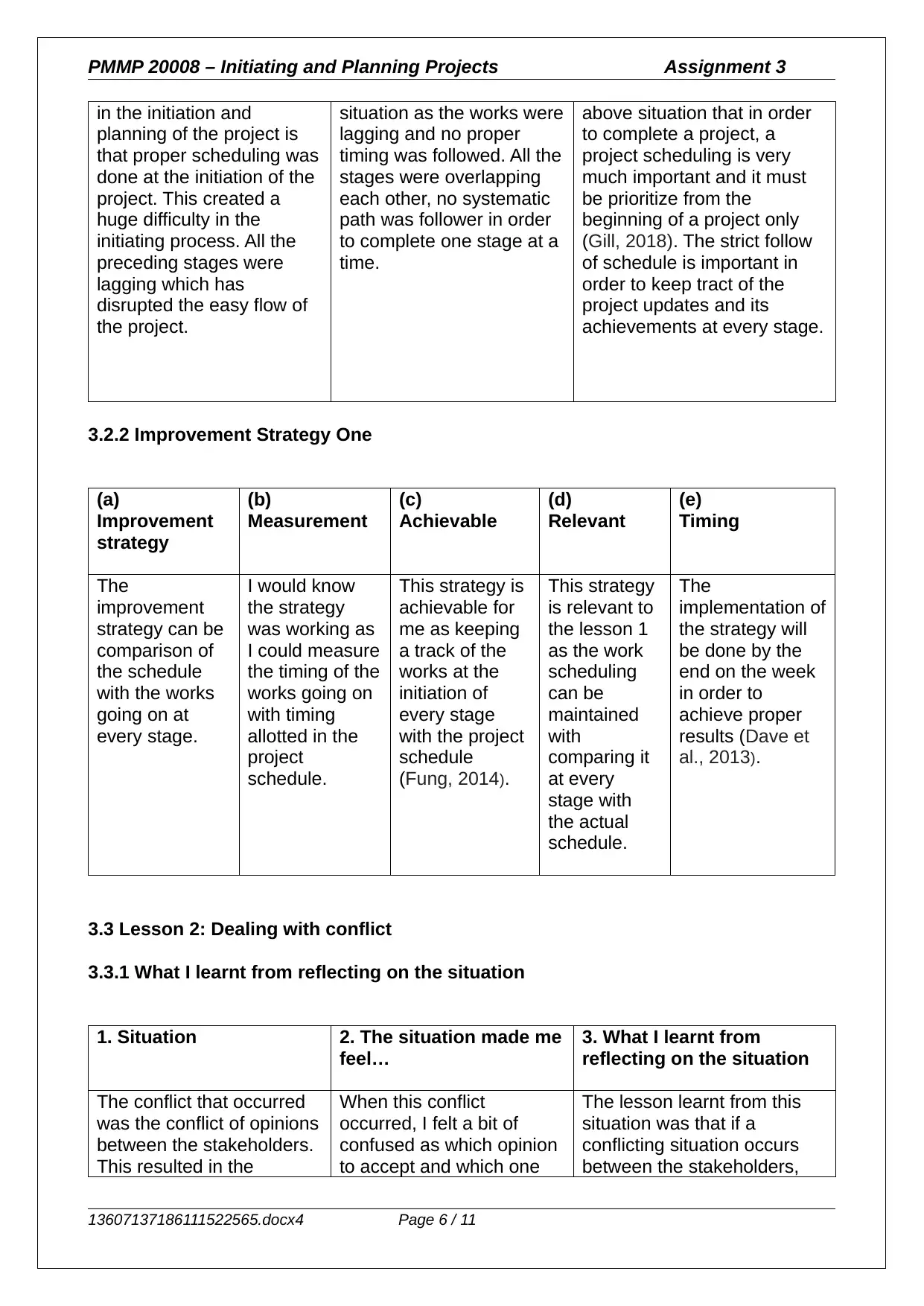
PMMP 20008 – Initiating and Planning Projects Assignment 3
in the initiation and
planning of the project is
that proper scheduling was
done at the initiation of the
project. This created a
huge difficulty in the
initiating process. All the
preceding stages were
lagging which has
disrupted the easy flow of
the project.
situation as the works were
lagging and no proper
timing was followed. All the
stages were overlapping
each other, no systematic
path was follower in order
to complete one stage at a
time.
above situation that in order
to complete a project, a
project scheduling is very
much important and it must
be prioritize from the
beginning of a project only
(Gill, 2018). The strict follow
of schedule is important in
order to keep tract of the
project updates and its
achievements at every stage.
3.2.2 Improvement Strategy One
(a)
Improvement
strategy
(b)
Measurement
(c)
Achievable
(d)
Relevant
(e)
Timing
The
improvement
strategy can be
comparison of
the schedule
with the works
going on at
every stage.
I would know
the strategy
was working as
I could measure
the timing of the
works going on
with timing
allotted in the
project
schedule.
This strategy is
achievable for
me as keeping
a track of the
works at the
initiation of
every stage
with the project
schedule
(Fung, 2014).
This strategy
is relevant to
the lesson 1
as the work
scheduling
can be
maintained
with
comparing it
at every
stage with
the actual
schedule.
The
implementation of
the strategy will
be done by the
end on the week
in order to
achieve proper
results (Dave et
al., 2013).
3.3 Lesson 2: Dealing with conflict
3.3.1 What I learnt from reflecting on the situation
1. Situation 2. The situation made me
feel…
3. What I learnt from
reflecting on the situation
The conflict that occurred
was the conflict of opinions
between the stakeholders.
This resulted in the
When this conflict
occurred, I felt a bit of
confused as which opinion
to accept and which one
The lesson learnt from this
situation was that if a
conflicting situation occurs
between the stakeholders,
13607137186111522565.docx4 Page 6 / 11
in the initiation and
planning of the project is
that proper scheduling was
done at the initiation of the
project. This created a
huge difficulty in the
initiating process. All the
preceding stages were
lagging which has
disrupted the easy flow of
the project.
situation as the works were
lagging and no proper
timing was followed. All the
stages were overlapping
each other, no systematic
path was follower in order
to complete one stage at a
time.
above situation that in order
to complete a project, a
project scheduling is very
much important and it must
be prioritize from the
beginning of a project only
(Gill, 2018). The strict follow
of schedule is important in
order to keep tract of the
project updates and its
achievements at every stage.
3.2.2 Improvement Strategy One
(a)
Improvement
strategy
(b)
Measurement
(c)
Achievable
(d)
Relevant
(e)
Timing
The
improvement
strategy can be
comparison of
the schedule
with the works
going on at
every stage.
I would know
the strategy
was working as
I could measure
the timing of the
works going on
with timing
allotted in the
project
schedule.
This strategy is
achievable for
me as keeping
a track of the
works at the
initiation of
every stage
with the project
schedule
(Fung, 2014).
This strategy
is relevant to
the lesson 1
as the work
scheduling
can be
maintained
with
comparing it
at every
stage with
the actual
schedule.
The
implementation of
the strategy will
be done by the
end on the week
in order to
achieve proper
results (Dave et
al., 2013).
3.3 Lesson 2: Dealing with conflict
3.3.1 What I learnt from reflecting on the situation
1. Situation 2. The situation made me
feel…
3. What I learnt from
reflecting on the situation
The conflict that occurred
was the conflict of opinions
between the stakeholders.
This resulted in the
When this conflict
occurred, I felt a bit of
confused as which opinion
to accept and which one
The lesson learnt from this
situation was that if a
conflicting situation occurs
between the stakeholders,
13607137186111522565.docx4 Page 6 / 11
⊘ This is a preview!⊘
Do you want full access?
Subscribe today to unlock all pages.

Trusted by 1+ million students worldwide
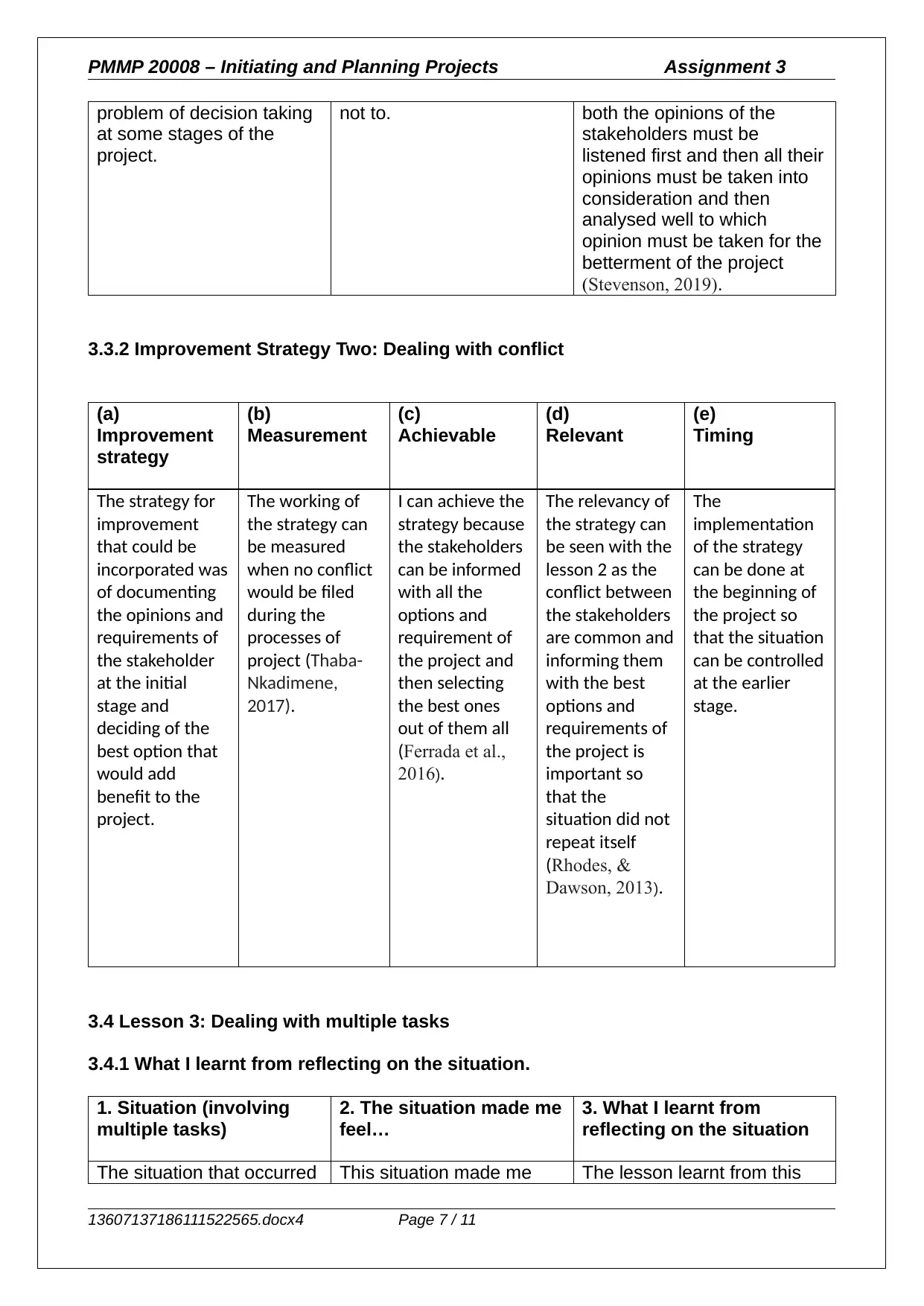
PMMP 20008 – Initiating and Planning Projects Assignment 3
problem of decision taking
at some stages of the
project.
not to. both the opinions of the
stakeholders must be
listened first and then all their
opinions must be taken into
consideration and then
analysed well to which
opinion must be taken for the
betterment of the project
(Stevenson, 2019).
3.3.2 Improvement Strategy Two: Dealing with conflict
(a)
Improvement
strategy
(b)
Measurement
(c)
Achievable
(d)
Relevant
(e)
Timing
The strategy for
improvement
that could be
incorporated was
of documenting
the opinions and
requirements of
the stakeholder
at the initial
stage and
deciding of the
best option that
would add
benefit to the
project.
The working of
the strategy can
be measured
when no conflict
would be filed
during the
processes of
project (Thaba-
Nkadimene,
2017).
I can achieve the
strategy because
the stakeholders
can be informed
with all the
options and
requirement of
the project and
then selecting
the best ones
out of them all
(Ferrada et al.,
2016).
The relevancy of
the strategy can
be seen with the
lesson 2 as the
conflict between
the stakeholders
are common and
informing them
with the best
options and
requirements of
the project is
important so
that the
situation did not
repeat itself
(Rhodes, &
Dawson, 2013).
The
implementation
of the strategy
can be done at
the beginning of
the project so
that the situation
can be controlled
at the earlier
stage.
3.4 Lesson 3: Dealing with multiple tasks
3.4.1 What I learnt from reflecting on the situation.
1. Situation (involving
multiple tasks)
2. The situation made me
feel…
3. What I learnt from
reflecting on the situation
The situation that occurred This situation made me The lesson learnt from this
13607137186111522565.docx4 Page 7 / 11
problem of decision taking
at some stages of the
project.
not to. both the opinions of the
stakeholders must be
listened first and then all their
opinions must be taken into
consideration and then
analysed well to which
opinion must be taken for the
betterment of the project
(Stevenson, 2019).
3.3.2 Improvement Strategy Two: Dealing with conflict
(a)
Improvement
strategy
(b)
Measurement
(c)
Achievable
(d)
Relevant
(e)
Timing
The strategy for
improvement
that could be
incorporated was
of documenting
the opinions and
requirements of
the stakeholder
at the initial
stage and
deciding of the
best option that
would add
benefit to the
project.
The working of
the strategy can
be measured
when no conflict
would be filed
during the
processes of
project (Thaba-
Nkadimene,
2017).
I can achieve the
strategy because
the stakeholders
can be informed
with all the
options and
requirement of
the project and
then selecting
the best ones
out of them all
(Ferrada et al.,
2016).
The relevancy of
the strategy can
be seen with the
lesson 2 as the
conflict between
the stakeholders
are common and
informing them
with the best
options and
requirements of
the project is
important so
that the
situation did not
repeat itself
(Rhodes, &
Dawson, 2013).
The
implementation
of the strategy
can be done at
the beginning of
the project so
that the situation
can be controlled
at the earlier
stage.
3.4 Lesson 3: Dealing with multiple tasks
3.4.1 What I learnt from reflecting on the situation.
1. Situation (involving
multiple tasks)
2. The situation made me
feel…
3. What I learnt from
reflecting on the situation
The situation that occurred This situation made me The lesson learnt from this
13607137186111522565.docx4 Page 7 / 11
Paraphrase This Document
Need a fresh take? Get an instant paraphrase of this document with our AI Paraphraser
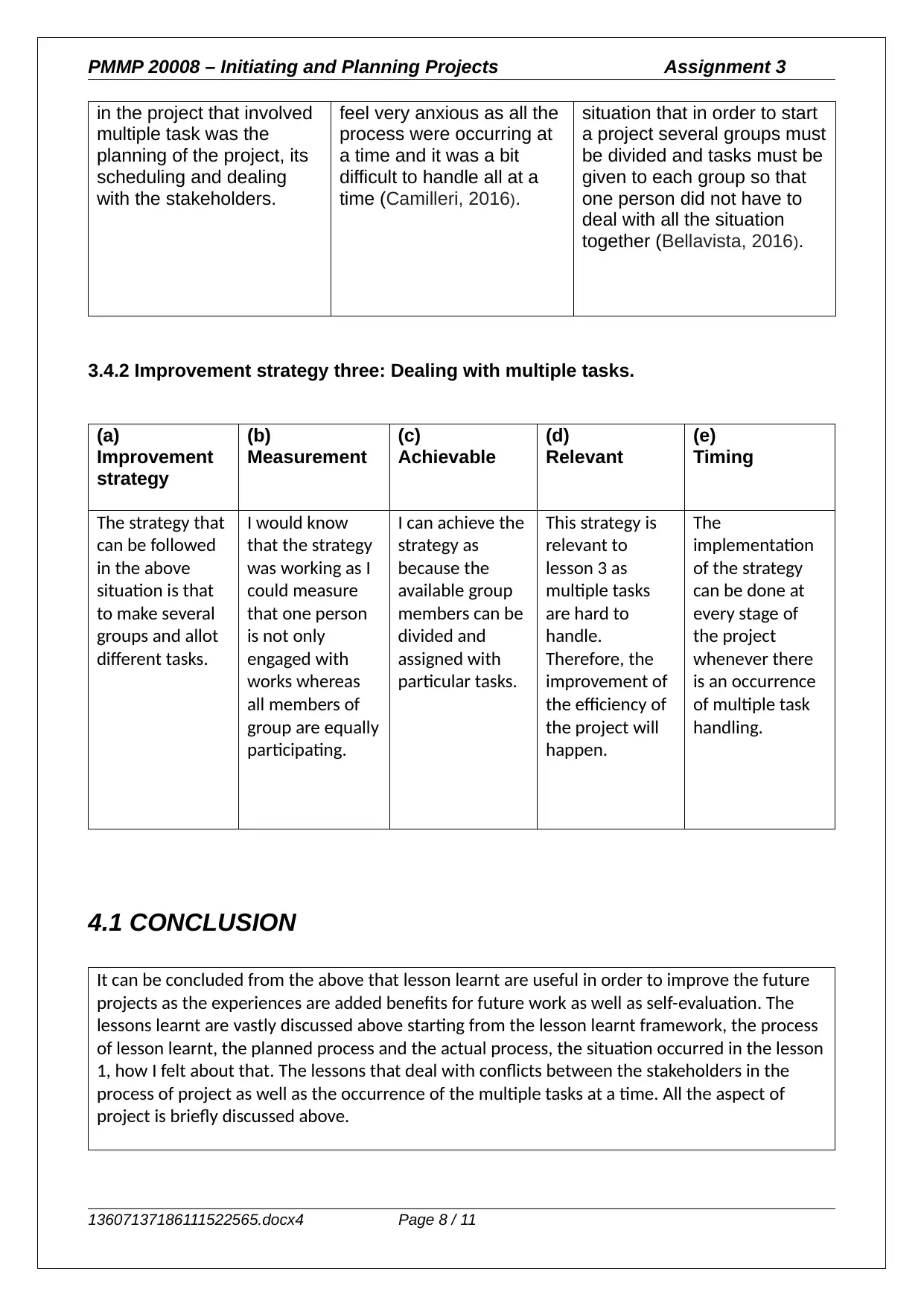
PMMP 20008 – Initiating and Planning Projects Assignment 3
in the project that involved
multiple task was the
planning of the project, its
scheduling and dealing
with the stakeholders.
feel very anxious as all the
process were occurring at
a time and it was a bit
difficult to handle all at a
time (Camilleri, 2016).
situation that in order to start
a project several groups must
be divided and tasks must be
given to each group so that
one person did not have to
deal with all the situation
together (Bellavista, 2016).
3.4.2 Improvement strategy three: Dealing with multiple tasks.
(a)
Improvement
strategy
(b)
Measurement
(c)
Achievable
(d)
Relevant
(e)
Timing
The strategy that
can be followed
in the above
situation is that
to make several
groups and allot
different tasks.
I would know
that the strategy
was working as I
could measure
that one person
is not only
engaged with
works whereas
all members of
group are equally
participating.
I can achieve the
strategy as
because the
available group
members can be
divided and
assigned with
particular tasks.
This strategy is
relevant to
lesson 3 as
multiple tasks
are hard to
handle.
Therefore, the
improvement of
the efficiency of
the project will
happen.
The
implementation
of the strategy
can be done at
every stage of
the project
whenever there
is an occurrence
of multiple task
handling.
4.1 CONCLUSION
It can be concluded from the above that lesson learnt are useful in order to improve the future
projects as the experiences are added benefits for future work as well as self-evaluation. The
lessons learnt are vastly discussed above starting from the lesson learnt framework, the process
of lesson learnt, the planned process and the actual process, the situation occurred in the lesson
1, how I felt about that. The lessons that deal with conflicts between the stakeholders in the
process of project as well as the occurrence of the multiple tasks at a time. All the aspect of
project is briefly discussed above.
13607137186111522565.docx4 Page 8 / 11
in the project that involved
multiple task was the
planning of the project, its
scheduling and dealing
with the stakeholders.
feel very anxious as all the
process were occurring at
a time and it was a bit
difficult to handle all at a
time (Camilleri, 2016).
situation that in order to start
a project several groups must
be divided and tasks must be
given to each group so that
one person did not have to
deal with all the situation
together (Bellavista, 2016).
3.4.2 Improvement strategy three: Dealing with multiple tasks.
(a)
Improvement
strategy
(b)
Measurement
(c)
Achievable
(d)
Relevant
(e)
Timing
The strategy that
can be followed
in the above
situation is that
to make several
groups and allot
different tasks.
I would know
that the strategy
was working as I
could measure
that one person
is not only
engaged with
works whereas
all members of
group are equally
participating.
I can achieve the
strategy as
because the
available group
members can be
divided and
assigned with
particular tasks.
This strategy is
relevant to
lesson 3 as
multiple tasks
are hard to
handle.
Therefore, the
improvement of
the efficiency of
the project will
happen.
The
implementation
of the strategy
can be done at
every stage of
the project
whenever there
is an occurrence
of multiple task
handling.
4.1 CONCLUSION
It can be concluded from the above that lesson learnt are useful in order to improve the future
projects as the experiences are added benefits for future work as well as self-evaluation. The
lessons learnt are vastly discussed above starting from the lesson learnt framework, the process
of lesson learnt, the planned process and the actual process, the situation occurred in the lesson
1, how I felt about that. The lessons that deal with conflicts between the stakeholders in the
process of project as well as the occurrence of the multiple tasks at a time. All the aspect of
project is briefly discussed above.
13607137186111522565.docx4 Page 8 / 11
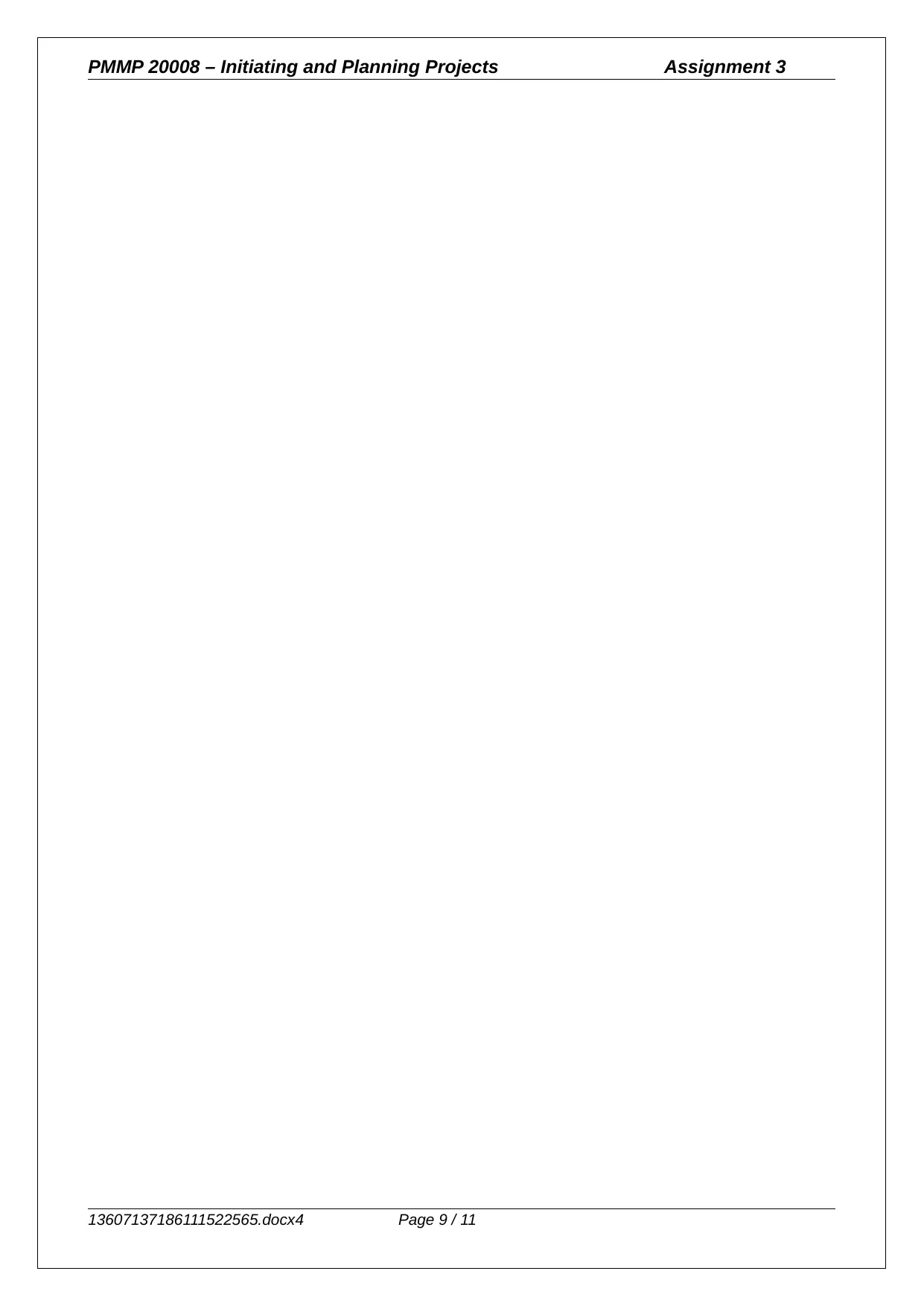
PMMP 20008 – Initiating and Planning Projects Assignment 3
13607137186111522565.docx4 Page 9 / 11
13607137186111522565.docx4 Page 9 / 11
⊘ This is a preview!⊘
Do you want full access?
Subscribe today to unlock all pages.

Trusted by 1+ million students worldwide
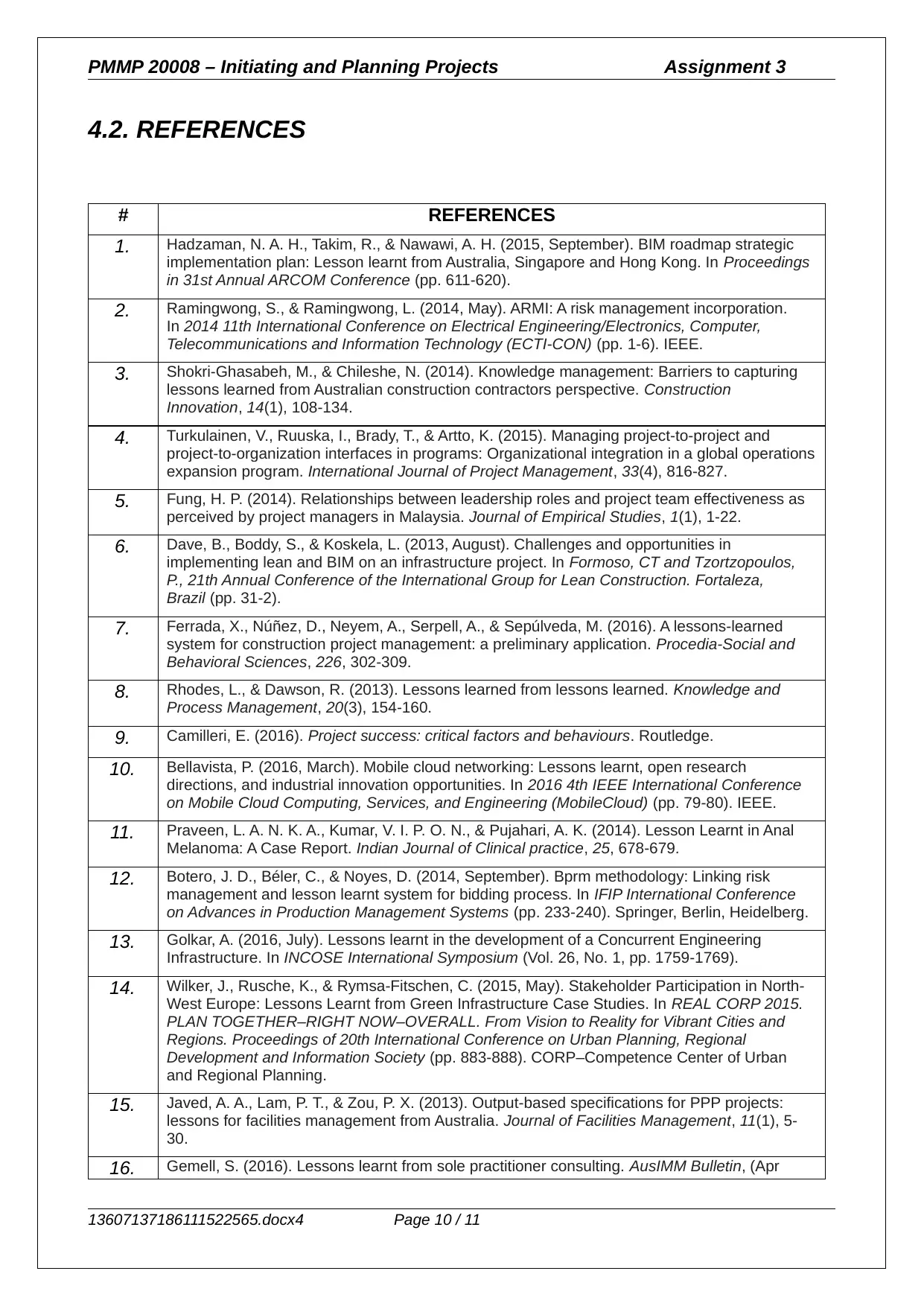
PMMP 20008 – Initiating and Planning Projects Assignment 3
4.2. REFERENCES
# REFERENCES
1. Hadzaman, N. A. H., Takim, R., & Nawawi, A. H. (2015, September). BIM roadmap strategic
implementation plan: Lesson learnt from Australia, Singapore and Hong Kong. In Proceedings
in 31st Annual ARCOM Conference (pp. 611-620).
2. Ramingwong, S., & Ramingwong, L. (2014, May). ARMI: A risk management incorporation.
In 2014 11th International Conference on Electrical Engineering/Electronics, Computer,
Telecommunications and Information Technology (ECTI-CON) (pp. 1-6). IEEE.
3. Shokri-Ghasabeh, M., & Chileshe, N. (2014). Knowledge management: Barriers to capturing
lessons learned from Australian construction contractors perspective. Construction
Innovation, 14(1), 108-134.
4. Turkulainen, V., Ruuska, I., Brady, T., & Artto, K. (2015). Managing project-to-project and
project-to-organization interfaces in programs: Organizational integration in a global operations
expansion program. International Journal of Project Management, 33(4), 816-827.
5. Fung, H. P. (2014). Relationships between leadership roles and project team effectiveness as
perceived by project managers in Malaysia. Journal of Empirical Studies, 1(1), 1-22.
6. Dave, B., Boddy, S., & Koskela, L. (2013, August). Challenges and opportunities in
implementing lean and BIM on an infrastructure project. In Formoso, CT and Tzortzopoulos,
P., 21th Annual Conference of the International Group for Lean Construction. Fortaleza,
Brazil (pp. 31-2).
7. Ferrada, X., Núñez, D., Neyem, A., Serpell, A., & Sepúlveda, M. (2016). A lessons-learned
system for construction project management: a preliminary application. Procedia-Social and
Behavioral Sciences, 226, 302-309.
8. Rhodes, L., & Dawson, R. (2013). Lessons learned from lessons learned. Knowledge and
Process Management, 20(3), 154-160.
9. Camilleri, E. (2016). Project success: critical factors and behaviours. Routledge.
10. Bellavista, P. (2016, March). Mobile cloud networking: Lessons learnt, open research
directions, and industrial innovation opportunities. In 2016 4th IEEE International Conference
on Mobile Cloud Computing, Services, and Engineering (MobileCloud) (pp. 79-80). IEEE.
11. Praveen, L. A. N. K. A., Kumar, V. I. P. O. N., & Pujahari, A. K. (2014). Lesson Learnt in Anal
Melanoma: A Case Report. Indian Journal of Clinical practice, 25, 678-679.
12. Botero, J. D., Béler, C., & Noyes, D. (2014, September). Bprm methodology: Linking risk
management and lesson learnt system for bidding process. In IFIP International Conference
on Advances in Production Management Systems (pp. 233-240). Springer, Berlin, Heidelberg.
13. Golkar, A. (2016, July). Lessons learnt in the development of a Concurrent Engineering
Infrastructure. In INCOSE International Symposium (Vol. 26, No. 1, pp. 1759-1769).
14. Wilker, J., Rusche, K., & Rymsa-Fitschen, C. (2015, May). Stakeholder Participation in North-
West Europe: Lessons Learnt from Green Infrastructure Case Studies. In REAL CORP 2015.
PLAN TOGETHER–RIGHT NOW–OVERALL. From Vision to Reality for Vibrant Cities and
Regions. Proceedings of 20th International Conference on Urban Planning, Regional
Development and Information Society (pp. 883-888). CORP–Competence Center of Urban
and Regional Planning.
15. Javed, A. A., Lam, P. T., & Zou, P. X. (2013). Output-based specifications for PPP projects:
lessons for facilities management from Australia. Journal of Facilities Management, 11(1), 5-
30.
16. Gemell, S. (2016). Lessons learnt from sole practitioner consulting. AusIMM Bulletin, (Apr
13607137186111522565.docx4 Page 10 / 11
4.2. REFERENCES
# REFERENCES
1. Hadzaman, N. A. H., Takim, R., & Nawawi, A. H. (2015, September). BIM roadmap strategic
implementation plan: Lesson learnt from Australia, Singapore and Hong Kong. In Proceedings
in 31st Annual ARCOM Conference (pp. 611-620).
2. Ramingwong, S., & Ramingwong, L. (2014, May). ARMI: A risk management incorporation.
In 2014 11th International Conference on Electrical Engineering/Electronics, Computer,
Telecommunications and Information Technology (ECTI-CON) (pp. 1-6). IEEE.
3. Shokri-Ghasabeh, M., & Chileshe, N. (2014). Knowledge management: Barriers to capturing
lessons learned from Australian construction contractors perspective. Construction
Innovation, 14(1), 108-134.
4. Turkulainen, V., Ruuska, I., Brady, T., & Artto, K. (2015). Managing project-to-project and
project-to-organization interfaces in programs: Organizational integration in a global operations
expansion program. International Journal of Project Management, 33(4), 816-827.
5. Fung, H. P. (2014). Relationships between leadership roles and project team effectiveness as
perceived by project managers in Malaysia. Journal of Empirical Studies, 1(1), 1-22.
6. Dave, B., Boddy, S., & Koskela, L. (2013, August). Challenges and opportunities in
implementing lean and BIM on an infrastructure project. In Formoso, CT and Tzortzopoulos,
P., 21th Annual Conference of the International Group for Lean Construction. Fortaleza,
Brazil (pp. 31-2).
7. Ferrada, X., Núñez, D., Neyem, A., Serpell, A., & Sepúlveda, M. (2016). A lessons-learned
system for construction project management: a preliminary application. Procedia-Social and
Behavioral Sciences, 226, 302-309.
8. Rhodes, L., & Dawson, R. (2013). Lessons learned from lessons learned. Knowledge and
Process Management, 20(3), 154-160.
9. Camilleri, E. (2016). Project success: critical factors and behaviours. Routledge.
10. Bellavista, P. (2016, March). Mobile cloud networking: Lessons learnt, open research
directions, and industrial innovation opportunities. In 2016 4th IEEE International Conference
on Mobile Cloud Computing, Services, and Engineering (MobileCloud) (pp. 79-80). IEEE.
11. Praveen, L. A. N. K. A., Kumar, V. I. P. O. N., & Pujahari, A. K. (2014). Lesson Learnt in Anal
Melanoma: A Case Report. Indian Journal of Clinical practice, 25, 678-679.
12. Botero, J. D., Béler, C., & Noyes, D. (2014, September). Bprm methodology: Linking risk
management and lesson learnt system for bidding process. In IFIP International Conference
on Advances in Production Management Systems (pp. 233-240). Springer, Berlin, Heidelberg.
13. Golkar, A. (2016, July). Lessons learnt in the development of a Concurrent Engineering
Infrastructure. In INCOSE International Symposium (Vol. 26, No. 1, pp. 1759-1769).
14. Wilker, J., Rusche, K., & Rymsa-Fitschen, C. (2015, May). Stakeholder Participation in North-
West Europe: Lessons Learnt from Green Infrastructure Case Studies. In REAL CORP 2015.
PLAN TOGETHER–RIGHT NOW–OVERALL. From Vision to Reality for Vibrant Cities and
Regions. Proceedings of 20th International Conference on Urban Planning, Regional
Development and Information Society (pp. 883-888). CORP–Competence Center of Urban
and Regional Planning.
15. Javed, A. A., Lam, P. T., & Zou, P. X. (2013). Output-based specifications for PPP projects:
lessons for facilities management from Australia. Journal of Facilities Management, 11(1), 5-
30.
16. Gemell, S. (2016). Lessons learnt from sole practitioner consulting. AusIMM Bulletin, (Apr
13607137186111522565.docx4 Page 10 / 11
Paraphrase This Document
Need a fresh take? Get an instant paraphrase of this document with our AI Paraphraser
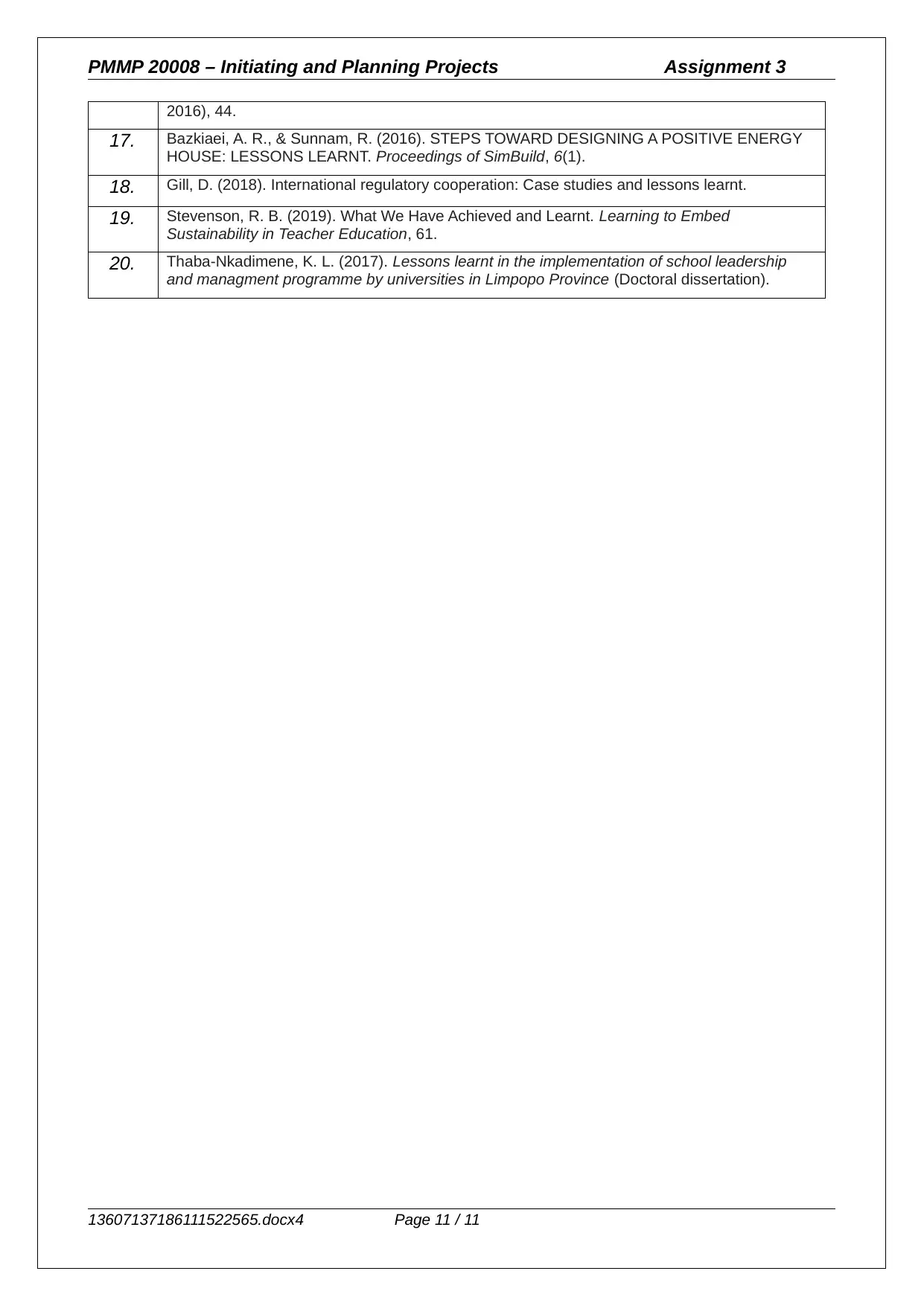
PMMP 20008 – Initiating and Planning Projects Assignment 3
2016), 44.
17. Bazkiaei, A. R., & Sunnam, R. (2016). STEPS TOWARD DESIGNING A POSITIVE ENERGY
HOUSE: LESSONS LEARNT. Proceedings of SimBuild, 6(1).
18. Gill, D. (2018). International regulatory cooperation: Case studies and lessons learnt.
19. Stevenson, R. B. (2019). What We Have Achieved and Learnt. Learning to Embed
Sustainability in Teacher Education, 61.
20. Thaba-Nkadimene, K. L. (2017). Lessons learnt in the implementation of school leadership
and managment programme by universities in Limpopo Province (Doctoral dissertation).
13607137186111522565.docx4 Page 11 / 11
2016), 44.
17. Bazkiaei, A. R., & Sunnam, R. (2016). STEPS TOWARD DESIGNING A POSITIVE ENERGY
HOUSE: LESSONS LEARNT. Proceedings of SimBuild, 6(1).
18. Gill, D. (2018). International regulatory cooperation: Case studies and lessons learnt.
19. Stevenson, R. B. (2019). What We Have Achieved and Learnt. Learning to Embed
Sustainability in Teacher Education, 61.
20. Thaba-Nkadimene, K. L. (2017). Lessons learnt in the implementation of school leadership
and managment programme by universities in Limpopo Province (Doctoral dissertation).
13607137186111522565.docx4 Page 11 / 11
1 out of 11
Related Documents
Your All-in-One AI-Powered Toolkit for Academic Success.
+13062052269
info@desklib.com
Available 24*7 on WhatsApp / Email
![[object Object]](/_next/static/media/star-bottom.7253800d.svg)
Unlock your academic potential
Copyright © 2020–2025 A2Z Services. All Rights Reserved. Developed and managed by ZUCOL.




